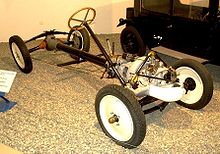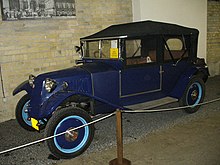Tatra 11
The Tatra 11 was a completely new small car developed by Hans Ledwinka , which was brought out by the Tatra factory in Kopřivnice (German: Nesselsdorf / Moravia) in 1923.
The vehicle had an overhead , air-cooled two - cylinder boxer engine with a displacement of 1056 cm³ and an output of 12 hp (9 kW). The engine drove the rear wheels via a multi-plate dry clutch and a four-speed gearbox with center shift and an articulated swing axle. The drive shafts were “jointless” - each drive shaft was rigidly connected to a ring gear that rolled on its drive pinion when it was compressed. The engine, gearbox and final drive were interlocked with the central tubular frame. The front axle was rigid and both axles were fitted with transverse leaf springs. Hand and foot brakes only worked on the rear wheels. The maximum speed of the 680 kg car was 72 km / h.
In addition to the four-seater tourer, there were also two- and four-door sedans, Landau, convertibles and roadsters with emergency seats, as well as a van with a box body. Within three years, 3540 copies were made.
In 1925 the Tatra-Werke presented a racing car, the Tatra 12 Targa Florio . The displacement of the engine remained unchanged, the maximum output was increased to 27 hp (20 kW) at 5000 rpm. This enabled the 560 kg monoposto to reach a top speed of 120 km / h. The engine had two intake valves per cylinder and the vehicle had brakes on all four wheels. The tank was behind the seat. Karl Sponer from Kornitz won the highly regarded Sicilian Targa-Florio race in 1925 (in the category up to 1100 cm³) and in second place his compatriot and mechanic Fritz Hückel in the second T 12, which was for the Tatrawerke, their chief designer Hans Ledwinka and for whom Tatra 12 was of great international importance.
As the successor to the Tatra 11 , the Tatra 12 came on the market from 1926 . The displacement of the engine remained the same, the maximum output was slightly higher at 13–14 hp (9.5–10.3 kW). Like the Tatra 12 Targa Florio, it also had brakes on the front wheels. It was also available as a six-seater for forestry under the name Normandie . 7525 wagons of the Tatra 12 were built in eight years.
After the Tatra 12 , the 57 was offered from 1932 (with a four-cylinder engine in the front and rear-wheel drive). Another successor, already with an overhead, air-cooled two-cylinder boxer engine as a rear engine , the type V 570 , got stuck in the prototype stage in 1933. But it became a model for the streamlined luxury car Tatra 77 , later also the KdF car and its legendary successful post-war successor series VW Beetle and Porsche 356 .
Between 1924 and 1933 the Tatra 13 van was offered with a 1056 cm³ engine and a payload of 1200 kg. The chassis was based on that of the Tatra 11. (later Tatra 12)
literature
- Wolfgang Schmarbeck: Tatras. The history of the Tatra automobiles. Verlag des Internationale Auto- und Motorrad-Museum Deutschland, Bad Oeynhausen 1977 2nd edition: Uhle and Kleimann, Lübbecke 1990, ISBN 3-922657-83-4






